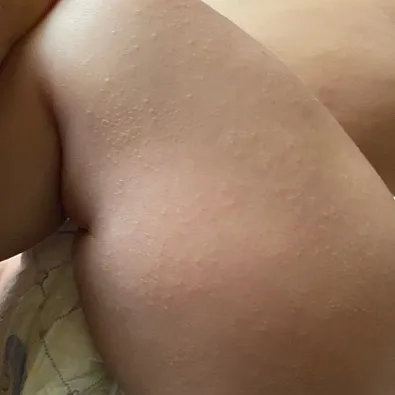![POOJA KOTHARI profile image of POOJA KOTHARI]() POOJA KOTHARIMom of a 8 yr 9 m old boy1 Year ago
POOJA KOTHARIMom of a 8 yr 9 m old boy1 Year agoA. Small bumps on a 9-month-old's legs could be caused by several things, and the treatment depends on the cause. Some common causes and their treatment options include:
1. Baby Acne (Milia):
Cause: Small white or skin-colored bumps, often found on the legs or face, are commonly seen in babies, especially in the first few months. These are often called "baby acne" or "milia."
Treatment: Typically, no treatment is needed. Baby acne usually clears up on its own within a few weeks. Gently wash the skin with mild baby soap and water.
2. Eczema (Atopic Dermatitis):
Cause: Red, itchy bumps with dry, scaly skin can be signs of eczema. It’s common in babies, especially on the arms and legs.
Treatment: Use a gentle, fragrance-free moisturizer (like petroleum jelly or a baby-friendly ointment) to keep the skin hydrated. Avoid harsh soaps or bath products. If the rash seems severe or itchy, consult your pediatrician, who may recommend a mild steroid cream.
3. Heat Rash (Miliaria):
Cause: Small red bumps that may be accompanied by warmth or redness are often caused by heat rash, which occurs when sweat gets trapped in the skin.
Treatment: Keep your baby cool and dry. Dress them in loose, breathable clothing. Avoid using heavy blankets or swaddling. If the rash is mild, it should clear up in a few days with good ventilation.
4. Insect Bites:
Cause: If the bumps are red and raised, they may be insect bites, such as mosquito bites.
Treatment: Apply a cold compress to reduce swelling. Use a baby-safe anti-itch cream or aloe vera gel. If the bites seem to be causing discomfort, consult your pediatrician.
5. Hives (Urticaria):
Cause: Raised, red, itchy bumps that appear suddenly can be a sign of hives, often triggered by an allergic reaction.
Treatment: If you suspect an allergic reaction (to food, a new detergent, etc.), remove the potential allergen. For hives, a doctor might recommend an antihistamine suitable for babies. If hives appear suddenly and are severe, or if your baby has difficulty breathing, seek immediate medical help.
6. Chickenpox:
Cause: If the bumps are fluid-filled and turn into blisters, chickenpox might be the cause, especially if there’s fever.
Treatment: If you suspect chickenpox, consult your pediatrician. The doctor can provide treatment options to relieve itching and discomfort.
General Care Tips:
Gentle Skin Care: Avoid using harsh soaps or lotions, and make sure to moisturize your baby’s skin with a gentle, fragrance-free product.
Avoid Scratching: Keep your baby’s nails short to prevent scratching and further irritation.
When to Consult a Pediatrician:
If the bumps persist, worsen, or seem to be causing discomfort.
If you notice fever, significant redness, or swelling around the bumps.
If your baby develops other symptoms, like difficulty breathing, swelling of the face or lips, or if the bumps appear to spread quickly.
It’s always a good idea to check with your pediatrician for an accurate diagnosis and the best treatment, especially if you are concerned or the bumps don’t resolve.






Post Answer